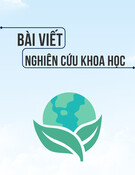
ISSN: 2615-9740
JOURNAL OF TECHNICAL EDUCATION SCIENCE
Ho Chi Minh City University of Technology and Education
Website: https://jte.edu.vn
Email: jte@hcmute.edu.vn
JTE, Volume 19, Issue 03, 2024
89
Generation Charaterristics of Solid Waste and Plastic Waste: A Case Study in
Long An Highschool
Nguyen Thi Tinh Au1, Dang Viet Hung2, Hoang Thi Tuyet Nhung1,*
1Ho Chi Minh City University of Technology and Education, Vietnam
2University of Technology, Vietnam National University-Ho Chi Minh City, Vietnam
*Corresponding author. Email: nhunghtt@hcmute.edu.vn
ARTICLE INFO
ABSTRACT
Received:
03/05/2024
Long An High School in Tan An, Long An, Vietnam, undertook a study to
examine the generation and physical composition of solid and plastic
waste. The study sampled 899 individuals, including officers, students, and
teachers. Solid waste was classified into five primary categories and
established three subcategories for plastic waste. The results showed that
the average daily waste generation rate at Long An High School is 0.13 kg
per student, including out-boarders who generate 0.028 kg per student, and
boarding and part-boarding students who generate 0.18 kg/person/day.
This rate is marginally lower than the waste generation rates observed in
households. The analysis of plastic waste at the school indicated that it
comprised 31% (35.65 kg/day) of the overall refuse generated. Boarding
and part-boarding pupils generate a daily plastic waste generation rate of
0.055 kg, while out-boarders generate 0.01 kg per person. Long An
Specialized High School receives recyclable plastic (46.5%), nylon bags
(35.3%), and non-biodegradable polystyrene (foam delivery packaging)
(18.2%) as its primary waste materials. Due to their lack of classification,
these wastes are challenging to recycle. In terms of refuse generation per
capita, male students produce 0.17 kg per male per day, while female
students generate 0.15 kg per female per day, on average. Male students
have an average discharge of 0.051 kg/male/day, which is 0.039
kg/female/day higher than female students' average discharges. In the case
of plastic No. 6 (foam delivery boxes), male pupils emit three times more
than female students.
Revised:
27/05/2024
Accepted:
06/06/2024
Published:
28/06/2024
KEYWORDS
Solid waste;
Plastic waste;
Audit;
School;
Survey.
Doi: https://doi.org/10.54644/jte.2024.1587
Copyright © JTE. This is an open access article distributed under the terms and conditions of the Creative Commons Attribution-NonCommercial 4.0
International License which permits unrestricted use, distribution, and reproduction in any medium for non-commercial purpose, provided the original work is
properly cited.
1. Introduction
Currently, the majority of countries around the globe are experiencing a waste crisis, including
Vietnam. In 2021, the world produced 353 million tons of plastic waste, but only 9% was recycled, 19%
was destroyed, and nearly 50% was buried in qualified landfills. In addition, 22% of plastic waste was
treated at improper landfills, burned at open-air landfills, or leaked into the environment, and the
remainder was released into the natural environment [1], [2]. The majority of the 1.8 million tons of
plastic waste produced annually in Vietnam is plastic bags. According to a report published by the
Ministry of Industry and Trade of Vietnam in February 2022, each Vietnamese household uses
approximately one kilogram of plastic bags per month, of which more than 80 percent are discarded
after a single use. Vietnam's per capita plastic consumption has increased by 41.3 kg in the past 28 years,
from 3.8 kg. In particular, the daily accumulation of single-use plastic that cannot be recycled and must
be interred reaches 80 tons in Hanoi and Ho Chi Minh City, the two largest cities in Vietnam [3], [4].
There are preparations underway to eliminate single-use plastic from convenience stores, supermarkets,
and urban markets by 2021, and the entire nation by 2025. Single-use plastic waste has direct effects on
life quality, human health, and other forms of life [5]. The non-biodegradable nature of plastic waste
poses the greatest threat. Even when buried in the mud, they persist for hundreds of years, altering the
physical properties of the soil, causing soil erosion, rendering the soil incapable of retaining water and
nutrients, and preventing oxygen from passing through the soil, thereby inhibiting the growth of plants,

ISSN: 2615-9740
JOURNAL OF TECHNICAL EDUCATION SCIENCE
Ho Chi Minh City University of Technology and Education
Website: https://jte.edu.vn
Email: jte@hcmute.edu.vn
JTE, Volume 19, Issue 03, 2024
90
species, etc.[6]. Plastic products are inextricably linked to the fossil fuel industry; therefore, the
extraction and transport of fossil fuels release carbon into the atmosphere, exacerbating global warming.
Numerous nations have realized that protecting the environment means safeguarding their own lives. In
addition to bans on single-use plastics by government policy tool, combating plastic pollution requires
a sense of community involvement and personal accountability.
Numerous waste management strategies were required to address the management of solid waste and
plastic waste [7], [8] . However, policymakers in Vietnam frequently fail to allocate sufficient attention
to the educational sector. Educational institutions are densely populated areas where the quantity of solid
refuse is frequently underestimated or not reported, and collection infrastructure is virtually non-
existent. Establishing a waste management system in educational settings not only guarantees students
access to clean and hygienic surroundings but also cultivates a deeper understanding of sustainable
practices, shaping their attitudes towards future pursuits such as housing and employment [9]. Data
regarding the generation of solid refuse and plastic waste in the schools of Tan An, Long An are currently
unavailable. We lack precise data regarding the origins and qualities of the produced refuse. However,
the stakeholders bear responsibilities for school waste management, which has led to the absence of
adequate guidelines for solid refuse management in schools. The audit's objective was to establish
fundamental data regarding the rates of solid waste and plastic waste production, as well as their
composition and quantity, at a sample of schools in the Long An region. Additionally, the study aimed
to evaluate the current campus waste management practices and provide suitable suggestions. As a
result, feasible and suitable alternatives that identify specific and locally relevant prospects for waste
reduction, reuse, and recycling can emerge, constituting a significant stride towards environmentally
sustainable and health-conscious educational institutions.
2. Materials and Methods
2.1. Study location.
Long An Specialized High School was established on December 28, 2009, in accordance with
Decision No. 2774/QD - People's Committee of Long An Province, on a total area of 38,457.31 m2
located at 112 Nguyen Minh Duong Street, Ward 4, Tan An, Long An Province.
There are 148 rooms (6 floors) in the dormitory area, of which 140 are student rooms and 8 are
administrative offices for faculty and staff. Canteen with a maximum capacity of 300 individuals.
In the school year 2022-2023, the total number of teachers, staff, and students is 899, comprised of
76 teachers and officials and staffs, 14 employees, and 809 students. 581 students out of 809 are residing
in boarding and part-boarding dorms (355 girls and 226 boys). There are 350 boarding students and 231
part-boarding students.
2.2. Current status of Long An Specialized High School's waste generation and management
The total amount of solid waste generated by the school, including three areas: The majority of the
waste from the dormitory, canteen, and school (classroom and school yard waste) consists of organic
waste, such as leaves and leftovers, and inorganic waste, such as paper, paper boxes, aluminum cans,
plastic bottles, nylon bags, foam takeaway boxes, etc. Unsorted garbage. Students use a large number
of disposable containers, non-biodegradable foam takeaway boxes to eat in the classroom, etc., so the
amount of plastic waste is typically quite high (qualitative).
Garbage from dorms
Each dormitory room has its own trash can; trash is not separated. Some students have engaged
in waste recycling for the purpose of selling them. Students collect all garbage in their room at the end
of the day or when the bins are full and transport it to the dormitory's dump site. The amount of waste
plastic that is disposable is quite high (qualitative). The school's cleaning staff will separate recyclables
and non-recyclables prior to the garbage truck's daily collection at 1:30 p.m.

ISSN: 2615-9740
JOURNAL OF TECHNICAL EDUCATION SCIENCE
Ho Chi Minh City University of Technology and Education
Website: https://jte.edu.vn
Email: jte@hcmute.edu.vn
JTE, Volume 19, Issue 03, 2024
91
Canteen garbage
Contractors sort canteen waste to separate food scraps for use as fish food (farm raised outside the
school). Recyclables and nonrecyclables are separated from dormitory and school waste and placed in
the trash for collection.
Figure 1. The canteen area categorizes leftovers for
use as fish food (students sort themselves from the tray)
Figure 2. Remaining garbage (in addition to the
leftovers put in the sorting bin, the remaining garbage
is disposed of in the large trash bin)
Classroom waste
The waste from classrooms is collected in 15L trash cans located in the hallway outside each
classroom. The students transport them (as assigned daily) to the large trash cans in the schoolyard at
the end of the school day or when the bin is full. The cleaning staff sweeps and collects leaves in a
separate bin, but parks them all together in the garbage collection vehicle of the public service provider.
2.3. Solid waste audit methods
Garbage is collected from the garbage dump site (located in the dormitory) and waste bins in the
canteen and on the schoolyard.
Dormitory solid waste: randomly sample 30 dorm rooms (15 male rooms and 15 female rooms) and
collect their trash in a separate container for classification. On each sample, the following information
is recorded: male/female room, number of rooms, number of people, and sampling date. Weigh and
classify the amount of waste generated by 30 randomly selected rooms. Determine the total volume of
garbage in the dormitory by weighing the entire amount of waste, including a representative sample.
Figure 3. Solid waste audit chart
For solid waste in the canteen and in classroom: Weigh the entire daily amount of waste in both
areas, then randomly select one trash bin from each area (ensuring that the quantity is greater than 20%)
for auditing. Weigh the volume of garbage in each container, then pour the garbage from each container
onto a tarp, and then sort it.

ISSN: 2615-9740
JOURNAL OF TECHNICAL EDUCATION SCIENCE
Ho Chi Minh City University of Technology and Education
Website: https://jte.edu.vn
Email: jte@hcmute.edu.vn
JTE, Volume 19, Issue 03, 2024
92
Four types of waste exist: organic waste, hazardous waste, recyclable waste, and residual waste. In
the plastic waste group, separate plastic classification and a comprehensive audit of plastics, with a focus
on single-use plastic waste, are required (styrofoam takeaway boxes, plastic bottles, plastic cups, straws,
etc.)
2.4. Online survey
Part 1: Information regarding survey participants: grade, gender, residence
Part 2: The extent and location of food use
Situation regarding waste single-use plastics
Sorting garbage and using single-use plastic as a habit
Awareness of disposable plastic
3. Results and Discussion
3.1. Weight and composition of generated solid waste.
3.1.1. Solid waste audit of the entire school
According to audited data statistics, the entire school generates an average of 115.1 kg of waste per
day, with a total of 899 people, including 76 teachers and staff; and 14 employees; 809 students. 581
(71.8%) of the 809 students were boarding/part -boarding students, while 228 (28.2%) were outboard
students. The average per capita school rate is calculated to be 0.13 kg/person/day. However, this is an
average that includes both boarding/part -boarding student and outboarding students, i.e. the number of
students staying all day and the number of people students staying at home without lunch are
average calculated together, so this number is inadequate. To more precisely distinguish the separate
means for boarding/part -boarding and outboarding, we have detailed analysis in Figure 9.
Table 1. Solid waste audit results for the entire school (including dormitory, canteen and classroom)
No.
Solid waste types
Weight, kg/day
kg/person/day
% (w/w)
1
Total solid waste
115.1
0.13
100
2
Organic solid waste
27.3
0.030
23.7
3
Hazardous solid waste
0.5
0.001
0.4
4
Recyclable solid waste
41.3
0.046
35.9
5
Residual solid waste
46.0
0.051
40
The auditing process sorts waste into four types: organic waste, hazardous waste, recyclable waste,
and residual waste [10]. Organic waste represented 23.7% (27.3 kg/day), recyclable waste represented
35.9% (41.3 kg/day), and non-recyclable waste represented 40% (46 kg/day), hazardous waste accounts
for nearly 0.4% (0.5kg/day) (Table 1). In the audit procedure, organic waste includes a portion of
leftovers with water and high humidity, resulting in a hefty weight. Although leaves from the school and
dormitory premises are organic waste, they are not included in the organic waste statistics because of
separate collection. The leaves for the entire school were audited at a daily rate of 1.83 kilograms. Paper,
aluminum cans, PET (drinking water bottles), HPDE, and PP are included in the classification of
recyclable waste. Nylon plastic is also classified separately but is included in the group of recyclable
plastics. PS plastic group (primarily foam takeaway boxes) is categorized as residual plastic (non-
recyclable).
Each area (dorm, classroom, and canteen) generates a different amount of waste. In the dormitory
area, the highest amount of waste generated is 89.44kg/day, including organic waste 24.29kg/day (27%),
recyclable waste 30.02kg/day (33.4%), and hazardous waste 0.48 kg/day (0.5%), with the residual waste
amounting to 35.14kg/day (39.1%) (Figure 4). The results of the online survey, completed by 465
students (42.1% are boarders and 31.5% are part-boarders), are consistent with the measured results.
These are the two groups of students who frequently stay in the dormitory and frequently bring food to

ISSN: 2615-9740
JOURNAL OF TECHNICAL EDUCATION SCIENCE
Ho Chi Minh City University of Technology and Education
Website: https://jte.edu.vn
Email: jte@hcmute.edu.vn
JTE, Volume 19, Issue 03, 2024
93
eat at the dormitory (45% of respondents). The dormitory generates the greatest amount of waste
compared to the other two areas.
For classroom waste, the average daily discharge is 17.6 kg, with recyclable waste such as milk
cartons, paper, plastic water bottles (9.01 kg/day), organic waste, etc. accounting for a small amount
(1.13 kg/day) (Figure 4). The majority of boarding/part-boarding students eat in the dormitory, out-
boarders eat at home, and the canteen has a place to discharge leftover food. Therefore, almost no
leftover food is in the classroom; instead, it is mainly recyclable waste and disposable plastic.
The average amount of waste generated in the canteen area is only 8.0 kg per day, with non-
recyclable waste accounting for 3.81 kg/day. Leftover food from the canteen is separated and used to
make fish food, so organic waste is negligible, at 1.92 kg/day. The daily number of recyclables is 2.27
kilograms, the majority of which consists of plastic bottles, plastic cups, and plastic straws (Figure 4).
Figure 4. Waste classification of Long An Specialized High School according to three areas
According to audit results, the average total amount of plastic waste in the entire school is 35.65
kg/day (representing 31%), of which plastic waste generated from dormitory accounts for 75% (26.77
kg/day) (Figure 5). These results are relevant to 71.8% of students who reside in boarding or part-
boarding. Some students bring food to class, which accounts for 19% of the classroom’s plastic waste
(6.59 kg/day). Comparatively, only 6% (2.29 kg/day) of the plastic waste in the canteen is due to students
buy food to eat at the dormitory and in class (23.2% of respondents eat in class) (Figure 6).
Figure 5. Plastic waste percentage in Long An Specialized High School according to three areas.
In a survey of 465 students regarding plastic waste disposal (including plastic bottles, nylon bags,
foam takeaway boxes, plastic cups, and plastic straws), 54.1% dispose of 1-2 items per day, 42.4%
dispose of 2-5 items per day, 2% dispose of 5-10 items per day, and 1.5% dispose of more than 10 items
per day.
Figure 6. Plastic waste classification of Long An Specialized High School according to three areas
24,29 1,92
1,13
30,02 2,27 9,01
35,14 3,81 7,02
D O R M I T O R Y
C A N TE E N
C L A S S R O O M
KG/DAY
Organic waste Recyclable waste Residual waste
Dormitory
75%
Canteen
6%
Classroom
19%
24,29 1,92 1,13
26,77 2,29
6,59
38,91 3,80 9,44
D O R M I T O R Y C A N T E E N CL A S S R O O M
KG/PERSON/DAY
Organic waste Plastic waste


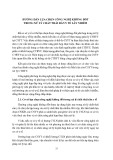

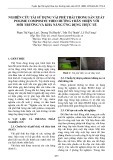
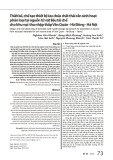

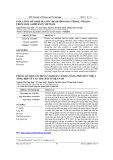
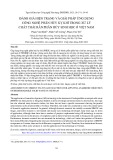
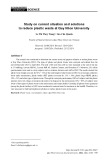

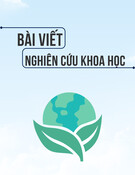
![Tài liệu Vi sinh vật môi trường [Mới nhất]](https://cdn.tailieu.vn/images/document/thumbnail/2025/20251123/ngkimxuyen/135x160/21891763953413.jpg)
![Sổ tay truyền thông Phân loại chất thải rắn sinh hoạt trên địa bàn tỉnh Quảng Nam [Chuẩn nhất]](https://cdn.tailieu.vn/images/document/thumbnail/2025/20251114/kimphuong1001/135x160/1701763094001.jpg)

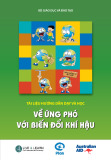
![Quản lý chất thải nguy hại: Sổ tay Môi trường [Chuẩn nhất]](https://cdn.tailieu.vn/images/document/thumbnail/2025/20251029/kimphuong1001/135x160/9011761720170.jpg)




